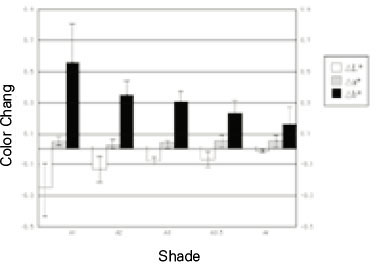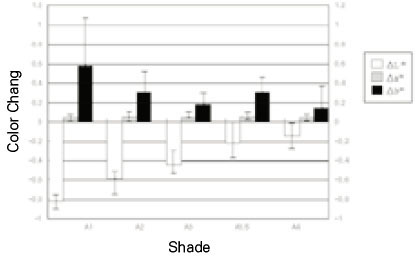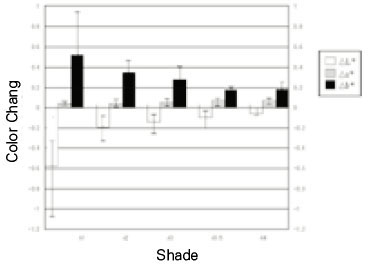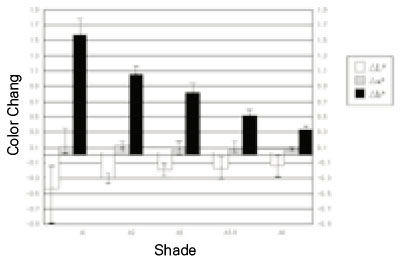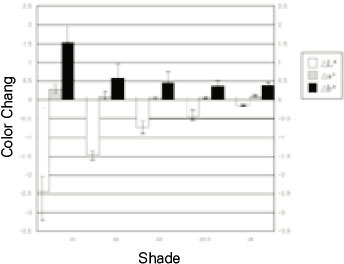J Korean Acad Conserv Dent.
2003 May;28(3):195-202. 10.5395/JKACD.2003.28.3.195.
Color changes in composite resins exposed to xenon lamp
- Affiliations
-
- 1Department of Conservative Dentistry, College of dentistry, Chosun University, Korea. ygcho@mail.chosun.ac.kr
- KMID: 2175580
- DOI: http://doi.org/10.5395/JKACD.2003.28.3.195
Abstract
- The purpose of this study was to evaluate the color changes of the composite resin resulting from xenon lamp exposure in different environments. Composite resin (Z 250 ; shade A1, A2, A3, A3.5, and A4) were applied in a cylindrical metal mold. Seventy five specimens according to environments of exposure were made as follows; Group I: aluminum foiling of the specimens in the air at 37degrees C for 1 day and 7 days. Group II: exposure of xenon lamp to the specimens in the air at 37degrees C for 1 day and 7 days. Group III: exposure of xenon lamp to the specimens in distilled water at 37degrees C for 1 day and 7 days. The color characteristics (L*,a*,b*) of the specimens before and after exposure of xenon lamp were measured by spectrophotometer and the total color differences (DeltaE*) were computed. The results obtained were as follows: 1. In all groups except A1 shade of group III, the DeltaE* values presented below 2.0, and group III showed the highest DeltaE* values followed by group II and group I in a decreasing order(p<0.05). 2. In all shades and groups, the more the exposure time of xenon lamp and the lighter the shade were, the higher the tendency for discoloration (p<0.05). 3. The composite resins which was exposed to xenon lamp in the distilled water was more discolored than those in the air (p<0.05). 4. The major changes of composite resins which were exposed to xenon lamp in the air were an increase in yellowness through a positive shift of the b* value, and those in the distilled water were an increase in darkness and yellowness through a negative shift of the L* value and a positive shift of the b* value.
Keyword
Figure
Cited by 1 articles
-
Effects of the color components of light-cured composite resin before and after polymerization on degree of conversion and flexural strength
Ji-A Yoo, Byeong-Hoon Cho
J Korean Acad Conserv Dent. 2011;36(4):324-335. doi: 10.5395/JKACD.2011.36.4.324.
Reference
-
1. Brauer GM. Color changes of composites on exposure to various energy sources. Dent Mater. 1988. 4:55–59.
Article2. Fruits TJ, Duncanson MG, Miranda FJ. In vitro weathering of selected direct esthetic reto-rative materials. Quintessence Int. 1997. 28:409–414.3. Luce MS, Campbell CE. Stain potential of four microfilled composites. J Prosthet Dent. 1988. 60:151–154.
Article4. Powers JM, Fan PL, Raptis CN. Color stability of new composite restorative materials under accelerated aging. J Dent Res. 1980. 59:2071–2074.
Article5. Stober T, Gilde H, Lenz P. Color stabiliy of highly filled composite resin materials for facings. Dent Mater. 2001. 17:87–94.6. Shin HS, Hwang HK, Cho YG. A study on the staining tendency of esthetic restorative materials. J Korean Acad Conserv Dent. 1995. 20:372–383.7. Chan KC, Fuller JL, Hormati AA. The ability of foods to stain two composite resin. J Prosthet Dent. 1980. 43:542–545.8. Barkmeier WW, Cooley RL. Evaluation of surface finish of microfilled resins. J Esthet Dent. 1989. 1:139–143.
Article9. Burrow MF, Makinson OF. Color change in light-cured resins exposed to daylight. Quintessence Int. 1991. 22:447–452.10. Kim MJ, Cho YG. Color Chances in Composites According to Various Light Curing Sources. J Korean Acad Conserv Dent. 2002. 27:87–94.11. Ji CK. Lighting Theory. 2002. Seoul: Munundang;80–81.12. Leibrock A, Rosentritt M, Lang R, Behr M, Handel G. Colour stability of visible light-curing hybrid composites. Eur J Prosthodont Restor Dent. 1997. 5:125–130.13. Plastics-methods of exposure to laboratory light. International Standard ISO 4892. 1981.14. New American dental Association Specification No. 27 for direct filling resins. J Am Dent Assoc. 1977. 94:1191–1194.15. Noie F, Keeefe KL, Powers JM. Color stability of resin cements after accelerated aging. Int J Prosthodont. 1995. 8:51–55.16. Swift EJ Jr, Hammel SA, Lund PS. Colorimetric evaluatioin of vita shade resin composites. Int J Prosthodont. 1994. 7:356–361.17. Asmussen E. Factor affecting the color stability of restorative resins. Acta Odontol Scand. 1983. 41:11–18.18. Ferracane JL, Moser JB, Greener EH. Ultraviolet light-induced yellowing of dental resto-rative resins. J Prosthet Dent. 1985. 54:483–487.
Article19. Powers JM, Dennison JB, Koran A. Color stability of restorative resins under accelerated aging. J Dent Res. 1978. 57:964–970.
Article20. Uchida H, Vaidyanathan J, Viswanadhan T, Vaidyanathan TK. Color stability of dental composites as a function of shade. J Prosthet Dent. 1998. 79:372–377.
Article21. Hintze H. Klinische und Physikalische Untersuchungen der Farbbestandigkeit von Zahnarztlichen F llungskunststoffen. Freie Universität Berlin;Inaugural-Dissertation.22. Viohl J. Color stability of dental resins. Quintessence Int. 1980. 3:Report 1860.23. Viohl J. Verfarbung von Kunststoffen durch unterschiedliche Lichtquellen. Dtsch Zahnarztl Z. 1976. 31:910–914.24. Choi HK, Kang TE, Kim JH, Park HM. Lighting Installation and Design. 2000. Seoul: Sungandang;82–83.25. Asmussen E. An accelerated test for color stability of restorative resins. Acta Odontol Scand. 1981. 39:329–332.
Article26. Seghi RR, Jonston WM, O'Brien WJ. Performance assessment of colorimetric devices on dental porcelain. J Dent Res. 1989. 68:1755–1759.
Article27. Seghi RR, Gritz MD, Kim J. Colorimetric changes in composites resulting fromvisible-light-initiated polymerization. Dent Mater. 1990. 6:133–137.
Article28. Phillips RW. Skinner's science of dental materials. 1982. 8th ed. Philadelphia: WB Saunders;232.
- Full Text Links
- Actions
-
Cited
- CITED
-
- Close
- Share
- Similar articles
-
- Understanding of the color in composite resin
- Evaluation of the Color Adjustment Potential of Single-Shade Composite Resin in Primary Teeth
- Color Comparison of Maxillary Primary Anterior Teeth and Various Composite Resins using a Spectrophotometer
- Surface roughness and color stability of various composite resins
- A study on the color stability of porcelain repair resins



